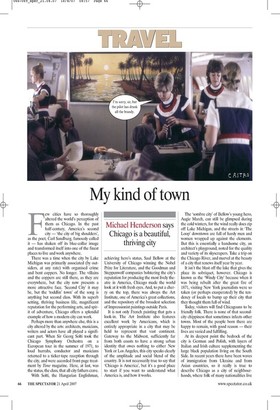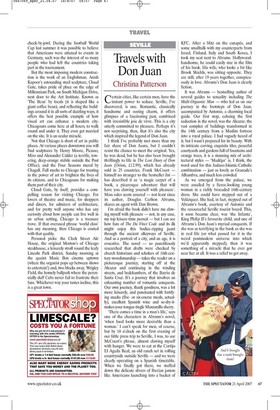My kind of town
Michael Henderson says Chicago is a beautiful, thriving city
Few cities have so thoroughly altered the world’s perception of them as Chicago. In the past half-century, America’s second city — ‘the city of big shoulders’, as the poet, Carl Sandburg, famously called it — has shaken off its blue-collar image and transformed itself into one of the finest places to live and work anywhere.
There was a time when the city by Lake Michigan was primarily associated (by outsiders, at any rate) with organised crime and bent coppers. No longer. The villains and the coppers are still there, as they are everywhere, but the city now presents a more attractive face. ‘Second City’ it may be, but the ‘toddlin’ town’ of the song is anything but second class. With its superb setting, thriving business life, magnificent reputation for the performing arts, and spirit of adventure, Chicago offers a splendid example of how a modern city can work.
Perhaps more than anywhere else, this is a city altered by the arts: architects, musicians, writers and actors have all played a significant part. When Sir Georg Solti took the Chicago Symphony Orchestra on a European tour in the summer of 1971, to loud hurrahs, conductor and musicians returned to a ticker-tape reception through the city, and were accorded front-page treatment by Time magazine. Here, at last, was the status, the class, that all city fathers crave.
With Solti, the Hungarian Englishman, achieving hero’s status, Saul Bellow at the University of Chicago winning the Nobel Prize for Literature, and the Goodman and Steppenwolf companies bolstering the city’s reputation for producing the most lively theatre in America, Chicago made the world look at it with fresh eyes. And, to put a cherry on the top, there was always the Art Institute, one of America’s great collections, and the repository of the broadest selection of Impressionist paintings outside Paris.
It is not only French painting that gets a look-in. The Art Institute also features excellent work by Americans, which is entirely appropriate in a city that may be held to represent that vast continent. Gateway to the Midwest, sufficiently far from both coasts to have a strong urban identity that owes nothing to either New York or Los Angeles, this city speaks clearly of the amplitude and social blend of the country. It is not necessarily true to say that ‘Chicago is America’, but it’s a good place to start if you want to understand what America is, and how it works. The ‘sombre city’ of Bellow’s young hero, Augie March, can still be glimpsed during the cold winters, for the wind really does zip off Lake Michigan, and the streets in ‘The Loop’ downtown are full of hardy men and women wrapped up against the elements. But this is essentially a handsome city, an architect’s playground, noted for the quality and variety of its skyscrapers. Take a trip on the Chicago River, and marvel at the beauty of a city that renews itself year by year.
It isn’t the blast off the lake that gives the place its sobriquet, however. Chicago is known as the ‘Windy City’ because when it was being rebuilt after the great fire of 1871, visiting New York journalists were so taken (or perhaps exasperated) by the tendency of locals to bump up their city that they thought them full of wind.
Today, visitors will find Chicagoans to be friendly folk. There is none of that secondcity chippiness that sometimes infects other towns. Most of the people born there are happy to remain, with good reason — their lives are varied and fulfilling.
At its deepest point the bedrock of the city is German and Polish, with layers of Italian and Irish culture supplementing the large black population living on the South Side. In recent years there have been waves of immigration from Ukraine and from Asian countries, so it really is true to describe Chicago as a city of neighbourhoods, where folk of many nationalities live cheek-by-jowl. During the football World Cup last summer it was possible to believe that Americans were attuned to events in Germany, such was the interest of so many people who had left the countries taking part in the tournament.
But the most imposing modern construction is the work of an Englishman. Anish Kapoor’s astounding steel sculpture, Cloud Gate, takes pride of place on the edge of Millennium Park, on South Michigan Drive, next door to the Art Institute. Known as ‘The Bean’ by locals (it is shaped like a giant coffee bean), and reflecting the buildings around it in all sorts of dazzling ways, it offers the best possible example of how visual art can enhance a modern city. Chicagoans come here at all hours, to walk round and under it. They even get married on the site. It is an ocular miracle.
Not that Chicago is short of art in public places. At various places downtown you will find sculptures by Henry Moore, Picasso, Miro and Alexander Calder (a terrific, towering, deep-orange stabile outside the Post Office), and the Four Seasons mural by Chagall. Full marks to Chicago for trusting in the power of art to brighten the lives of its citizens, and to Chicagoans for making them part of their city.
Cloud Gate, by itself, provides a compelling reason for visiting Chicago. For lovers of theatre and music, for shoppers and diners, for admirers of architecture, and for pretty well anyone who has any curiosity about how people can live well in an urban setting, Chicago is a treasure trove. If that overused phrase ‘world class’ has any meaning, then Chicago is coated with that quality.
Personal picks: the Clark Street Ale House, the original Morton’s of Chicago steakhouse, a leisurely stroll round the leafy Lincoln Park district, Sunday morning at the quaint Music Box cinema uptown (where the organist pops up between shows to entertain!) and, two blocks away, Wrigley Field, the homely ballpark where the perennially duff Cubs never fail to frustrate their fans. Whichever way your tastes incline, this is a great town.



















































































 Previous page
Previous page